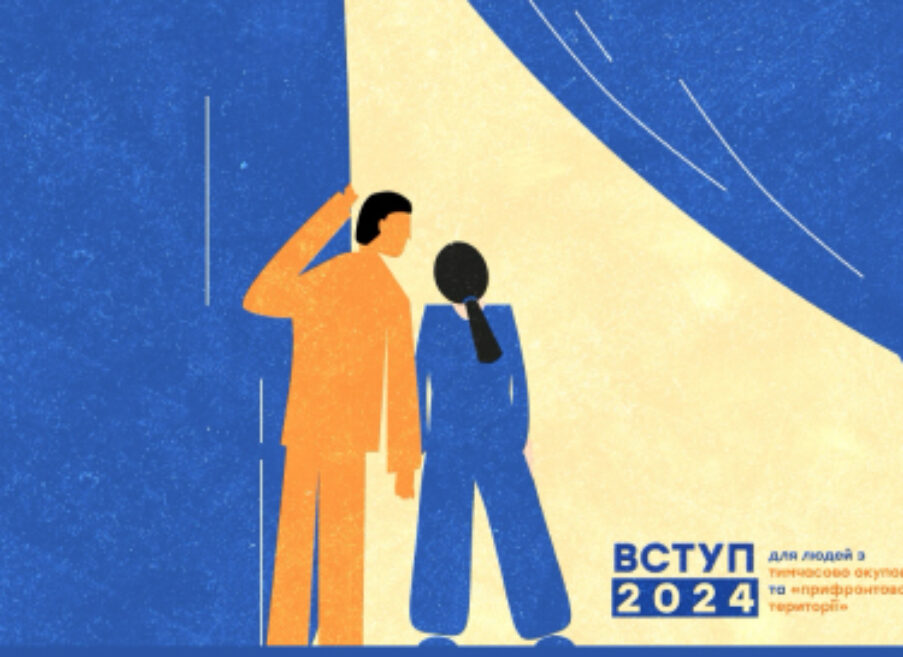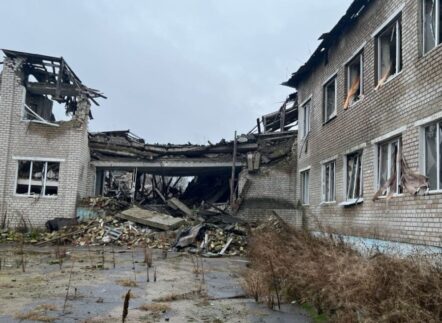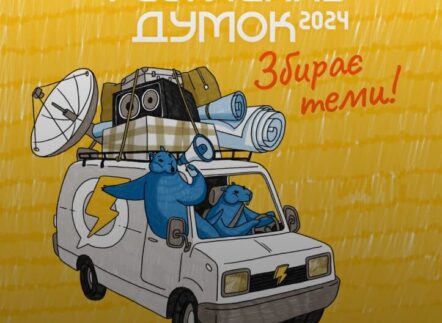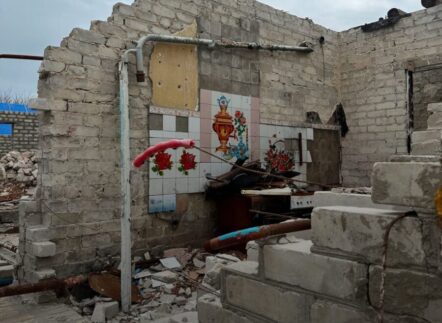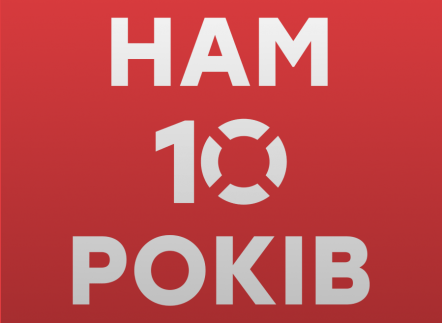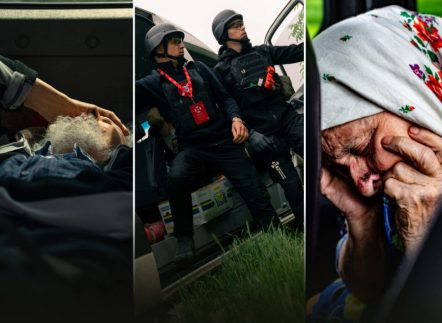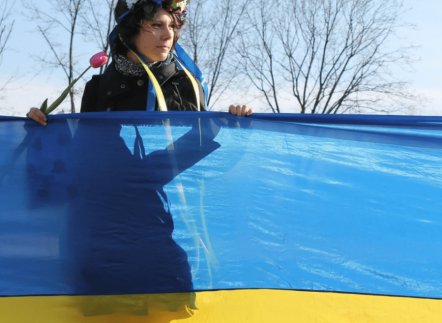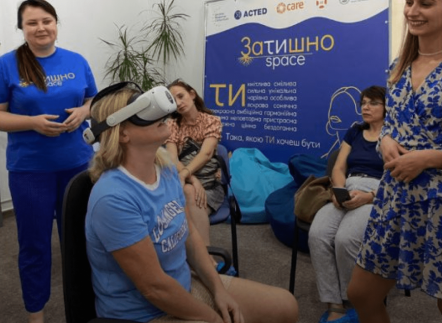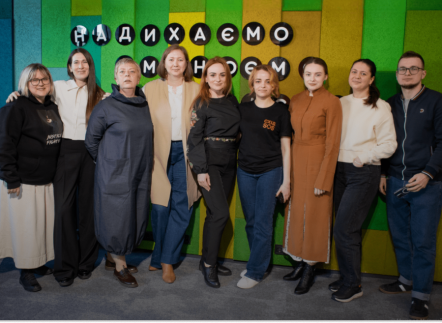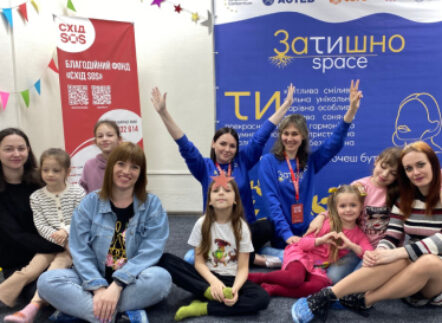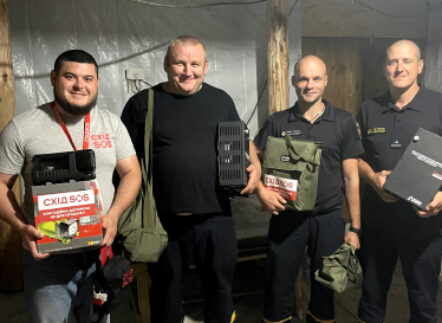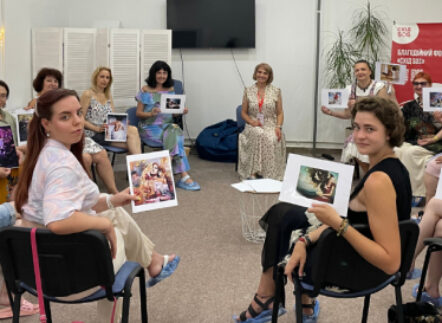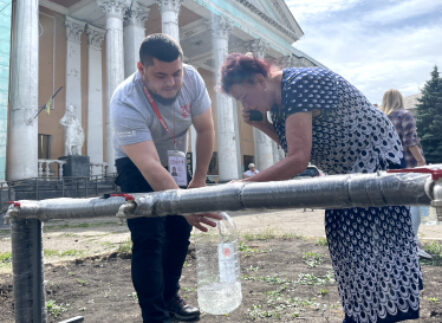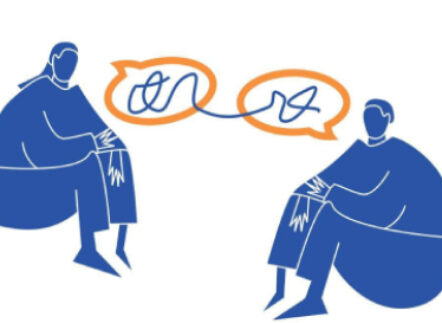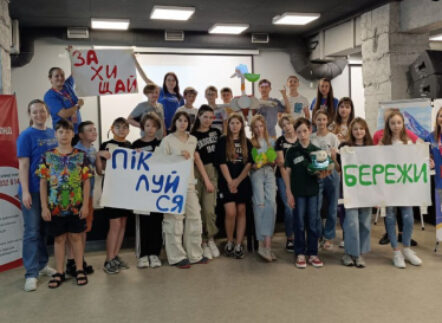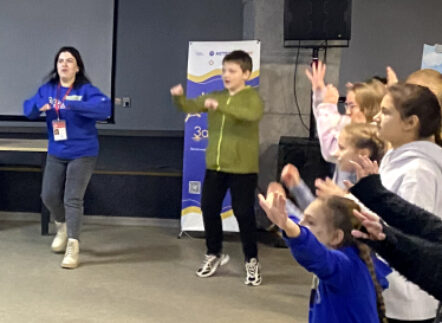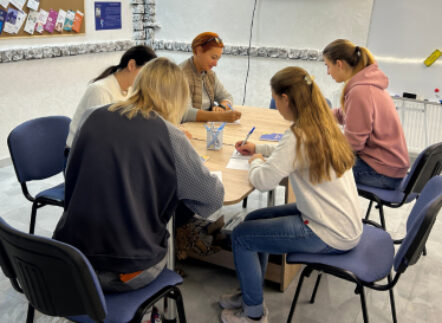
A Report on Local Characteristics and Needs
Download the full PDF report
View the full report online
Editor: Imke Hansen
Authors: Imke Hansen, Julia Samokhvalova
Research: Imke Hansen, Julia Samokhvalova, Tatyana Dontsova, Milan Zaytsev
Editing: Kate Bellamy
Photos: Imke Hansen, Milan Zaytsev, Marco Fieber
Layout: Marco Fieber
The report is based on information gathered between July and December 2019 and was funded by the German Foreign Office.
Civil Society in the Conflict Zone of Luhansk
Only few Ukrainian citizens actively engage in civil society. This is partly a legacy of the Soviet Union, where the state permeated nearly all spheres of life, raised citizens to be passive, and absorbed civic activity through state-organized manifestations, campaigns, and movements. The climate of corruption, predatory capitalism and stalling reforms during political transition continued to spur the mass distrust of political institutions and to show that a citizen’s capacity to effect social change is very limited.
However, the Euromajdan and the conflict in East Ukraine contributed greatly to changing this situation, significantly impacting practices, organisational forms, and mobilisation patterns of civil society. “Surprisingly”, writes Orysia Lutsevich, “volunteering and non-state initiatives have also surged in the southeast of Ukraine. Historical perspective is crucial to understanding the capacity of citizens in that region to engage in reform. Despite continuous Western assistance to civil society, little aid reached the southeast of the country prior to 2014. Nor was the local environment conducive to a vibrant civil society: an entrenched Soviet-era mentality, a paternalistic outlook on the part of government officials, a lack of critical thinking and decades of single-party rule had led to a culture of submission and fear of challenging authority.”
Now, civil society has developed into a diverse field, and a significant player in the daily life of the conflict zone, even though it still has enormous potential to grow further. All over Donbas, it fills gaps left by the failure of the state to cover its citizens´ needs. Whereas the trust in state institutions is still very low, people´s trust in civil society, particularly in volunteers, seems relatively high.
Ukrainian civil society and particularly the civil society in the East Ukrainian conflict zone deserve a closer examination to identify capacities and shortages, opportunities for development, and areas that support.
Whereas there is a considerable number of analytical articles on this topic, our report mainly provides insights from the grass-roots level: observations and remarks from civil society actors based in the region of Luhansk, both members of civil society organisations (CSO) and informally organized actors, who shared their views during our training- and mentoring-project “Empowerment for Dialogue”.
Following some general observations of civil society´s impact factors and areas of activity, we provide a detailed description of civil society in five towns – Severodonetsk, Shastya, Zolote, Popasna and Stantytsia Luhanska, based on the voices of local agents of change and including the specific local conditions for civil society. We conclude our report with recommendations for future projects and aid to strengthen local civil society in the conflict area, particularly in the district of Luhansk.
Conditions & Impact Factors of Civil Society Activity
The conditions and impact factors of civil society activity are diverse and vary in different places and at different times. Below, we describe six impact factors mentioned to us most often, in various places. The distinction between conditions and fields of activity cannot be understood as rigid. It is often blurred by the fact that conditions, and particularly problems and shortcomings, are at the same time a field of civil society activity.
Mobility and access
The infrastructure in the area of conflict is in poor condition. Most roads are in a bad state. Inhabitants report that improvements, if they happen, often do not last, due to the substandard quality of the material and the limited work that contractors invest. In rural areas, many (sand) roads are hardly passable after rain or snow.
Public transport is running with low frequency. To reach a town to join a meeting and get back afterwards using public transport is barely possible in many places. Remote places and some locations close to the frontline are not served by public transport at all. If one can afford it, one can pay a private driver.
The bad state of the road network and of public transport contributes to the isolation of people, limits the accessibility of shopping facilities and medical care, and certainly also the possibilities for participating in civil society events. It also constitutes a security issue when evacuation routes are blocked or impassable. Knowing about the road situation contributes to a general feeling of insecurity – people worry that if heavy shelling starts again, they will not be able to escape.
The front line is further limiting mobility, access to schools, workplaces or shopping facilities, as well as the possibility to visit family, or join civil society activity. The district of Luhansk has only one entry-exit check point (EECP; see picture above), which is is located in Stanytsia Luhanska. It can only be crossed by pedestrians, whereas EECPs in Donetsk region can be crossed by car.
Locals complain that the crossing procedure is complicated: Long queues keep people waiting for hours, often in the heat of summer without any protection from the sun, or in the frost of winter – equally without any weather protection. Particularly old people and people in poor health have difficulties with queuing for the EECP. In summer, it is particularly dangerous that people do not drink enough water to avoid going to the toilet – as this would force them to give up their place in the queue. Due to these difficulties, there have been repeated cases of people dying on their way to the other side of the frontline.
As mentioned before, the limited mobility of people hampers civil society activity. We could see in our project that it is often too difficult for people to come to town to attend a meeting or a discussion. Getting together with like-minded people beyond the inhabitants of one’s own village is always connected with a huge effort, and many times is simply not possible.
Space
Often, locals report a lack of space for meeting and organizing events. Private homes are usually not spacious enough to hold meetings comprising several people. In summer, the yards of apartment blocks and, in rural areas, benches or improvised sitting areas in front of a local shop constitute areas where people meet, exchange information, voice needs and coordinate informal networks and support functions. In winter, this communication is severely limited.
Previously, workplaces, the huge factories and mines provided space for cultural and social activity, organized talks, dances and other social events. With the decline of these industries, towns and settlements are now lacking these spaces. This is more painful in settlements that do not even offer a public café where people could meet each other.
Many settlements still possess a “house of culture” (Dom Kultury), a legacy from Soviet times. However, many of them are barely usable, or not usable at all, due to a lack of heating and the urgent need for renovation. Local libraries also serve as public spaces where meetings can take place. The extent to which CSOs and informal actors of civil society can use these spaces depends on local conditions and actors.
High mine contamination limits the possibilities to use outdoor spaces for civil society activity. Moreover, this is likely to contribute to a sense of all-encompassing insecurity that can negatively impact peoples readiness to become active (see chapter on warfare). Due to the lack of suitable spaces for civil society activity, the creation of spaces is thus often the goal of civic engagement.
Work and economy
For many inhabitants of the conflict zone, the economic situation is tough. Mines and other industries have closed down or are under threat of closure. Workers are often paid late. Businesses moved away from war due to insecurity, high risk and bad infrastructure. The government does not offer any support for opening a business in the conflict zone. Even farmers complain that private agriculture is hardly profitable and the government does not offer any support.
Many workplaces, among them the majority of mines, are now located on uncontrolled territory and therefore not really available for people who live on controlled territory. There are cases of people working on the “other side”, however that usually involves crossing the frontline away from an official crossing point, and thus includes high risk.
Unsurprisingly, unemployment is high. Our respondents estimate that only one third of those who could work have a job. The governmental unemployment support is minimal and many do not even manage to collect it due to limited mobility or bureaucratic obstacles.
Poor business conditions impact the possibilities for people to gather in public space, as we can see in Zolote, where there is not even a café where people can meet. More importantly, unemployment, poverty and insecurity can decrease people´s capacity to be active in civil society. Moreover, these issues are likely to contribute to a number of problems relevant both for the individual and for the community, such as stress, domestic violence, substance abuse, health issues.
Many people live in very poor conditions. In rural areas, not all houses are connected to the gas and water supplies. Some people have to carry drinking water from an outside well, or even from the central village well. Many people heat their houses with coal or, rather, coal dust. The quality of the coal used to heat homes is usually very low.
Due to unemployment, people have to find alternatives to maintain their livelihood, which often requires all family members to take part. Most people have a garden where they grow fruit and vegetables. Some people make money from selling their home-grown vegetables on local markets. The youngest participants of our project reported that teenagers often lack personal time and space as they have to support their parents, for instance regarding care of younger siblings. On weekends and during the holidays, they report to work in the garden, sell vegetables on the market, or contribute to the family´s livelihood in another way. This not only inhibits typical teenage activities, but it also limits their capacity to become interested and involved in civil society activity.
Dysfunctional families, scattered families, displacement
Family as an institution, but also as a value, is rated very highly in the area. Living with kin, spending time with family, visiting relatives on holidays, and helping family members seem the most natural things to do. This contrasts with the fact that most families in the conflict zone are not able to live family life as they would like to, and as they used to. Many families are scattered: one part of the family lives on the other side of the frontline, or the grandparents have stayed in the conflict zone, whereas children and grandchildren have moved to a safer place with employment possibilities and perspectives, and struggle with the difficulties of being Internally Displaced Persons (IDP). Grandparents complain that they do not see their grandchildren over the summer as they used to. A lot of communication between family members happens via Skype. IDPs and abandoned family members often suffer from isolation and a fundamental lack of networks of local assistance, as support is usually organized through informal family networks.
Many families face stress and tension caused by the conflict and the related economic and social situation. Trauma, insecurity, unemployment, poverty and the lack of perspective can cause or enhance substance abuse, individual disorders that affect an individual’s immediate environment and create dysfunctional families.
Moreover, the conflict line separates families not only spatially but also ideologically, as well as in terms of the mutually perceived quality of the relationship. Many of our participants complained about relatives living on the non-controlled side that would not take any interest in their problems, emphasizing instead their own difficulties. The feeling of being victimized and the inability to see the problems of others in the face of their own suffering contributes to further rifts and conflicts.
Conflict and instability within families can hamper the development of an active civil society as it limits people´s capacity to engage, join in and support a cause. Many of our respondents reported that they are so busy with helping family members that there is no time or strength left for civil society activity.
At the same time, supporting IDP-families and people who lack family is also an area of activity for civil society actors. Helping people to deal with stress and tension can contribute greatly to improved family life.
Warfare
Certainly, the ongoing warfare has an impact on local civil society. Some parts of the conflict zone are still affected by shelling. During our project, if there had been shelling the night before made a visible difference to the participants´ concentration, receptivity and openness to new ideas.
Another huge problem of the ongoing conflict is mine contamination. Eastern Ukraine is one of the most contaminated regions worldwide. Since April 2014, more than 1000 civilians have died or suffered injuries from mines and explosive remnants of war. In the government-controlled part of the conflict zone alone, about two million people are exposed to landmine risks. This contamination affects the daily life of around 70% of the families, who struggle to avoid contact with landmines.
Mine contamination affects the accessibility of farmland, schools, hospitals and other places of daily use. Moreover, it severely limits the possibilities for letting children play outside, as well as for any outdoor activity, contributing to a constant lack of safety (see left picture). International donors and humanitarian organisations engage both in demining and education, the latter in the form of mine risk awareness programmes for children and adults.
The constant presence of armed forces is another feature of war. Whereas inhabtants of the conflict zone report that they maintained strong ties with some battalions, particularly in the earlier years of war, they complain about others, attesting a lack of respect for the local population and their possessions. Substance abuse in the military also constitutes a problem: drunk armed soldiers on the streets contribute to the feeling of insecurity.
Often, citizens report problems with the Military Civil Administrations. We heard complaints about corruption, lack of competence and indifference to the problems of the local population. In places with Military Civil Administration, the local communities have basically no instruments to influence the local leadership or to issue complaints. There is thus no space for participation, leaving the population with the impression that there is no capacity to effect change.
In fall 2019, the Ukrainian government’s plans for subduing the conflict, including the disengagement of armed forces along the contact line, spurred protests in regional centres and settlements throughout Donbas. Opinion polls showed that over 70% of the population in Eastern Ukraine considered the withdrawal of armed forces from both sides of the contact line to be generally a good decision. In practise, nevertheless, it caused great stress for people who lived in the affected areas. During our project, we were able to witness that the disengagement took up all the attention of those participants who live in the affected areas. The disengagement is perceived as a decline in security, as some settlements are located between the checkpoints of both sides. Particularly pro-Ukrainian civil society activists feel unprotected from potential assaults from the other side. The movement of checkpoints and military security measures caused the closure of streets, which was also perceived as a threat, since local inhabitants fear not being able to escape in situations of acute threat.
Motivation
Civil society actors named very different motivations for their activities: Among others, they mentioned patriotism and nationalism, wanting to create a better Ukrainian society, filling the gaps the state fails to fill, locally helping oneself, supporting children and young people, and supporting marginalized people. People who are active in civil society do not necessarily belong to an organisation. On the contrary, informal structures of civil society action are widespread. According to our observation, many people prefer to be active within informal networks, often including family ties and friendships. A reason for that can be a lack of trust in CSOs, or a lack of access to them. Formalizing activity through the foundation or membership of a CSO can be also a bureaucratic hurdle.
Many active people stress that they are not seeking any support for themselves but want to become a capacity for supporting others. This indicates that they regard it as a moral value to commit to a higher cause and to care for others.
During our training and mentoring activities, it became apparent that participants enjoyed being surrounded by people with similar values and goals, and to share their worries, experiences and ideas. They reported that there are only a few people in their environment that they can talk to on this level. The conflict-related polarisation of citizens and rise in everyday conflicts affects traditional ties and local networks of people, potentially leading to isolation and an urgent desire for exchange with like-minded people.
Moreover, the participants seemed to be hungry for input, for methods and practices they can use in their civil society activity, their work and their everyday life. In face of the topics brought up and examples provided, it was evident that communication, stress and trauma were recurring topics of immense importance for participants. As the state does not offer support for the majority of the stress-drained and traumatized inhabitants of the conflict zone, locals identify this as a field of action for CSOs. They reported how personal inability to maintain one´s own boundaries, blurring boundaries between job and civil society activity, and the burden of feeling responsible and at the same time lacking time and resources to support their respective cause drains the energy of civil society actors, who asked for instruments and means to meet these problems.
Fields of Civil Society Activism
Civil society in East Ukraine is diverse. There are various causes that people support. Many of them are related to the conflict, as for instance the monitoring of conflict-related human rights violations, supporting IDPs, or the aforementioned education for mine awareness. There are, however, also people engaged in fighting corruption, monitoring governmental processes, promoting and informing about human and civic rights, providing alternative information, organizing cultural events, and protecting animal rights. In the following sections, we present four fields of civil society activism that participants are actively involved in, or that were discussed.
Reconstruction, humanitarian aid, supporting IDPs
In response to Russia´s occupation of Crimea and the conflict in Donbas, various initiatives have mushroomed to support IDPs, as well as people in the conflict zone, to mitigate the consequences of warfare. Providing IDPs with housing, work and initial basic support, and organizing humanitarian aid for villages close to the frontline were two important focal points of this wave of solidarity. International organisations such as the International Red Cross, the Norwegian Research Council, Diakonie and Caritas contributed funds for the reconstruction and repair of shelled houses and humanitarian aid.
Displacement and emigration, poor social integration and care of IDPs, former soldiers and victims of violence continue to put social cohesion at risk. In this field, the support of civil society is still needed. However, as the most urgent emergency situation seems to be over, since the hostilities have lowered in intensity and the humanitarian situation has improved compared to 2014–2016, support should take on other forms and address less the acute needs than the sustainable problems resulting from the situation.
Access to health care
The limited mobility in the region affects access to health care. Since for most inhabitants of rural areas it constitutes quite an effort to go to town, most people do not undergo regular preventive health checks. Often people even fail to see a doctor when they have been recommended to do so.
Ambulances take more than in hour to reach certain places in the conflict zone. Hospitals are only in the urban settlements, whereas rural places in the conflict area do not even have doctors. Due to the huge lack of physicians, paramedics are forced to fill in for them. Many places even lack a paramedic point and a basic pharmacy. Some paramedic points are poorly equipped (see picture on page 9) and open only very limited hours. Others are permanently closed due to lack of staff. Many types of medicine are expensive or, as in the case of poor people including pensioners, simply not affordable.
Given this situation, access to health care has become a field of local and international civil society activism. International donors fund resources and the distribution of medical equipment, however, to a limit extent that does not cover the needs. Within the limits of these resources, Ukrainian CSOs provide paramedic points with medicine and examination equipment, and organize for rehabilitation kits and other forms of medical aid to go directly to people in need. The intense phase of the war gave rise to the phenomenon of volunteers who organize medicine and provide paramedic points and local communities with it, often without being members of a CSO. Furthermore, there are informal networks of neighbours, family and friends that organize medical care for those members of their community who require of it. Particularly in villages, neighbour networks care for the needs of old and sick people. Informal actors also engage in the local organisation of humanitarian aid distribution.
Situation of children and young people
The conflict limits children´s access to middle school and higher education, as well as complicating their everyday life. Many schools have closed due to the migration of many families. The remaining children often have had to change schools, which may include a longer journey to school. Moreover, the frontline has cut off some villages from their closest school. School bus services do often not fully compensate for the difficulties. The children of Katerinovka, close to Zolote-4, have to walk 3km to catch the school bus. The children of Lobacheva have to walk or cycle 5km on a disastrous road to school. Without the conflict, they could go to the much closer school on the other side of the river but currently, this is uncontrolled territory.
The tough economic situation forces children to support their parents in trying to secure the family´s livelihood. Taking care of siblings, old and sick relatives, doing housework and helping to earn money, for instance by selling home-grown vegetables is placing them in a situation of huge responsibility and reducing their free time.
Young people particularly suffer from the lack of cultural and sporting activities. Teenagers report that there is hardly anything to do for them anymore. Often, they cannot practise their hobbies and develop their skills, as their dance instructors, soccer trainers and music teachers have emigrated from the conflict zone.
Parents, students and teachers agreed that school education has become more difficult for all involved. Teachers report that students have a higher level of aggression and a lower concentration span. Trauma and constant stress limit both the teachers´ and the students´ capacity to engage with the learning situation and content. Teachers admit that the methods they learned and employed throughout their career are not adequate or sufficient to teach the students in the current situation.
In this situation, support for children and teenagers is of utmost concern for many inhabitants of the conflict zone. This requires educational and recreational programmes, but also support for the network surrounding young people, particularly for teachers and parents. In the case of our participants, projects that help young people to deal with stress, trauma and disturbing memories are particularly necessary. They acknowledge the projects and programmes for schools and associations that address the problems of young people, however they ask for more, and more effective support.
Addressing the psycho-social consequences of war
The ongoing conflict greatly increases feelings of insecurity. Basically all the aforementioned conditions have the potential to destabilize and increase stress: Economic insecurity, limited mobility, shelling, the presence of armed soldiers, as well as “smuggling, trafficking in small arms and drugs, and the diffusion of weapons to government-controlled parts of the country contribute to the sense of insecurity.”
Increased conflicts in everyday life, high levels of aggression and the lowered capacity for listening both results from and fosters insecurity. The feelings of insecurity often go hand in hand with distrust, which can even include towards neighbours and other members of the local community, thereby complicating everyday communication and conflict resolution. This combination easily results in “suspicion of diversity, paternalism, a sense of victimization and deep-seated fear of change”, as Lutsevich et al. rightly concluded. Existing societal divides, the political polarisation and other conflict-related rifts further add to distrust, potentially creating a feeling of isolation. Moreover, most people did not have the resources and support to tackle and integrate their traumatic experiences. After a period of lower-intensity hostilities, they are just beginning to show.
Almost all people that attended the training, as well as medics from different regions, considered psychological support of people in the conflict zone, particularly trauma therapy, as one of the most urgent needs. They are asking for educational programmes to learn how to deal with their own trauma and how to support others, particularly children. The fact that throughout the training process, our participants continually asked for individual consultation meant that we provided more than 90 individual therapeutic sessions, supporting the assumption that therapeutic support is well needed. However, psychological support programmes have to overcome an obstacle, as psychology and psycho-therapy is often met with distrust or even neglect. One of the root causes for these attitudes is most probably the status of psychology in the USSR as pseudo-science, as well as the urge to present a flawless version of oneself to the outside world instead of talking about one´s fears and problems. This behavioural pattern also permeated post-Soviet education and socialisation.
Stanytsia Luhanska
Founded by Don Cossacks on the banks of Siverskyi Donetsk river in the late seventeenth century, Stanytsia Luhanska is an urban settlement in the very east of Luhansk region, 23 km from the Ukrainian-Russian border. As an agrarian town with small industries, including railway maintenance and food production, the city maintained strong economic ties with the region’s administrative and industrial center Luhansk, as well as with the rest of the Russian Federation. In light of the current situation, being cut off from Luhansk, it seems to be difficult for the town to reorient and develop ties to other towns on Ukrainian-controlled territory.
Stanytsia Luhanska is a very special place as it offers the only entry-exit crossing point (EECP, see left picture) in the whole district of Luhansk and thus the only possibility to legally and safely cross the frontline. The bridge can be used only by pedestrians, and every day thousands of people queue in front of the checkpoints on both sides to cross over the river to the other side. As a consequence, every workday the town is flooded with people who have come to collect their pensions and run errands. This “tourism” is a heavy burden for the already war-shaken population of Stanytsia Luhanska.
As the economic ties to the metropolis of Luhansk are very limited, a considerable proportion of the population of Stanytsia Luhanska has been deprived of their traditional sources of income. Nowadays, the EECP has become an important business. People offer rooms, transportation of goods and people, rides to the train station, and basically anything else the incoming “pension tourists” need. Inhabitants complain about the lack of sustainable business opportunities. Stanytsia is a high risk zone, where hardly anyone wants to invest. There are a few shops and cafes that mainly concentrate on the needs of the “tourists”.
Occupation, liberation, violence
As in other towns in eastern Ukraine, unrest broke out in late April 2014, when supporters of the “Russian Spring” came to the city from neighboring Luhansk. An armed group that called itself “Luhansk People’s Militia” under the leadership of the local warlord Oleksii Mozghovyi took over the building of the District State Administration on April 28, 2014 and set up a checkpoint at one of the four bridges connecting Stanytsia with Luhansk. What followed were months of escalation and heavy fighting over the strategically important gateway to the city of Luhansk. For almost two months, the supply of gas, electricity and water was interrupted. From August 18-21, 2014, the Ukrainian army succeeded in bringing the town under their control.
However from 2014-2016, Stanytsia Luhanska was targeted by intense shelling from weapons of all types and calibers, causing significant damage to its infrastructure and housing. The residential quarter around Lomonosov and Lebedinsky streets was particularly affected. From 13,774 inhabitants as of January 2014, the population of Stanytsia had dropped to approximately 7,200 by August 2015.
Meanwhile, most of the houses that are still inhabited, have been repaired. The whole part of the town that faces the frontline has new roofs. Still, the traces of war are more visible here than in any other urban settlement of Luhansk district. Housing reconstruction in Stanytsia Luhanska has been possible mainly due to international aid.
The Bridge
Even in the midst of crossfire, pedestrians and public transport continued to pass over the last bridge between Stanytsia and Luhansk. In early 2015, the Ukrainian administration closed the bridge to traffic. On March 19, 2015, it was heavily damaged in a severe shootout between the two sides, leaving Stanytsia virtually cut off from its main market, Luhansk, which remained under the control of illegitimate paramilitary units.
Later in 2015, the authorities established an official entry-exit checkpoint (EECP) across the heavily damaged bridge – the only one in the whole Luhansk region. Unlike the operating EECPs in Donetsk region, Stanytsia Luhanska only allows pedestrians to cross. The EECP constitutes a floodgate of people crossing to visit relatives and friends, to buy and sell goods, but most importantly, to gain access to Ukrainian pensions and other subsidies. In November 2014, Ukrainian authorities ceased to pay social benefits on non-government controlled territory. Until today, residents of the occupied territories have to register as Internally Displaced Persons (IDPs) on government-controlled territory and personally verify their identity in a bank every other month to receive pension or other subsidies. Consequently, senior citizens are flocking into the town every workday to verify themselves, pick up their pension and go shopping. This so-called “pension tourism” has fundamentally changed the face of Stanytsia Luhanska, and causes tension and animosity not only from the locals in Stanytsia Luhanska who have to queue in the banks among hundreds of residents from Luhansk and “LPR”, but also resentment from many Ukrainians who see them as opportunists taking advantage of the Ukrainian social system.
The destroyed bridge people had to cross on foot remained a key humanitarian concern for several years. Although temporary wooden ramps were built by the International Committee of the Red Cross in December 2017, crossing remained dangerous and troublesome, especially for the elderly and disabled people. Extreme weather conditions and stress have even led to several deaths. Only in fall 2019, was the bridge repaired and the road leading from the EECP to the bridge paved. Still, it is not open for vehicles. However, a bus and two electric cars of the United Nations Refugy Agency UNHCR carry individuals with limited mobility over the approximately 800 meters that divide the Ukrainian EECP from the bridge.
Approximately 10-15,000 people cross the EECP in Stanytsia Luhanska every day. Although there are no official statistics on population numbers, sources in the district administration say that approximately 10,000 people currently live in Stanytsia (January 2020). Two small medical points operate during the opening hours of the EECP – one before and one after the Ukrainian passport control post.
Conditions for civil society
Stanytsia Luhanska has a district administration, three schools, several banks, and a hospital. The hospital, however, does not possess modern medical equipment. For advanced treatments, people go to Luhansk or larger Ukrainian cities.
Moreover, there is a House of Culture with a library, a museum, and a sports stadium. The library was repeatedly hit by shelling and is currently under renovation (see right picture).
Numerous international organisations are active in Stanytsia. They mainly provide help with the maintenance and repair of houses and town institutions. Some offer humanitarian aid. The NGOs Proliska and Norwegian Refugee Council (NRC) have offices in Stanytsia.
Our respondents claim that cultural leisure time activities are needed. The fact that there are no opportunities for joint activities and entertainment affects their psychological situation, they argue. Particularly young people lack opportunities to meet and be inspired. Students try to organize activities themselves. The settlement does not have a center for activists or a youth center. Vostok-SOS has tried to create activity centers and centers of legal aid, but has faced problems with funds for activities, as well as with finding experienced and responsible people to run such a center.
According to our experience, it is not easy to work in Stanytsia Luhanska. People seem much more shy and hesitant to speak to strangers. Many prefer not to take sides in the conflict, or even to talk about it.
There is still a significant lack of job opportunities. Being separated from Luhansk, the town has not succeeded in developing trade and exchange with other towns and regions on Ukrainian controlled territory. People in Stanytsia Luhanska seem to suffer from stress, trauma and feelings of insecurity, and lack sustainable support in overcoming the difficult past six years.
The so-called “pension tourism” affects the town (see picture below). Our participants report that during the daytime, they do not have the impression that it is “their city” – only in the evening. During the working hours of offices and banks, the town is so crowded that they avoid going shopping, running errands, or doing other activities. After 4pm, the face of the town changes completely – most of the “tourists” leave, as the EECP closes at 6pm. The town becomes empty and silent. This contrast is characteristic of Stanytsia.
Disengagement
The agreement on disengagement provides for a mutual “mirror” withdrawal of both the Ukrainian Armed Forces (UAF) and the Russian-backed armed groups of the so called “LPR”, from areas measuring about 2×2 kilometers. Accordingly, disengagement measures were taken in fall 2019 in three pilot zones, which had been determined in 2016 by the Trilateral Contact Group in Minsk, and which includes the area of Stanytsia Luhanska. Both sides withdrew armed forces and weapons, while experts conducted partial demining.
The disengagement area in Stanytsia Luhanska is located on both banks of the Siverskyi Donets river, which serves as a natural barrier. It includes the EECP, some of the territory surrounding the EECP, and the residential quarter around Lomonosov and Lebedinsky streets. A railway bridge across the Siverskyi Donets and the river itself separate this area from the territories controlled by armed groups of the so-called “LPR.”
Local residents in Stanytsia Luhanska associate disengagement with the absence of military personnel and vehicles, rather than with less shelling, because the settlement has not been shelled for a while now. But both locals and observers note that despite the disengagement, Russian-backed armed groups have been setting up firing positions at dominant heights on the border of the disengagement area. Shelling outside Stanytsia Luhanska has often been reported.
The government does not ensure the safety of people in the demilitarized zones and seems to be unable to guarantee an unhindered operation of public/municipal authorities, the safety of civil servants and their families, or the safekeeping of public registers that may potentially be located in the new disengagement areas. The security measures currently in place are declarative and insufficient; the police does not properly patrol the demilitarized zones. The authorities do not offer people at risk living in the demilitarized zones any alternative solutions, such as assistance with relocation, to ensure their safety.
Shchastya
The town of Shchastya (whose name means happiness in Ukrainian) is located to the north of Luhansk, across the river Siverskyi Donets. Originally founded as a village in 1754, Shchastya grew immensely with the construction of the Luhansk Power Plant north of the settlement, which began in 1952. In 1958, the construction was completed. Shchastya has officially been a town since 1963.
Before the war, Shchastya was one of Luhansk´s administrative districts and a popular summer house area. In late April 2014, the town came under the control of the self-proclaimed “Lugansk People´s Republic” (“LPR”) until it was retaken by the volunteer battalion “Aidar” on June 14 of the same year. In October 2014, the government changed the administrative division in the Luhansk and Donetsk regions, to ensure the continued functioning of local administration, as many towns and settlements now belonged administratively to those districts under the control of the “LPR”. Currently Shchastya is administrated by a civil-military administration that is one of 20 at regional, district and settlement levels which are operating in the Luhansk and Donetsk regions.
The thermal power plant, running on sub-bituminous coal and natural gas, is the core industry in the small town. It employs more than 1000 people and is capable of feeding electricity to 98 percent of the region. It belongs to the company “DTEK Vostokenergo”, which is owned by Rinat Akhmetov. Almost everyone in the town is somehow connected to the plant – either s/he works there, or used to work there, or has family members working there. Currently, the power plant is under threat of closure. This would entail an enormous loss of jobs and a huge change in the social and economic situation of Shchastya and its inhabitants.
In the conflict, the power plant has been of crucial significance. As the only electricity source in the Luhansk region, it provides power to approximately one million people in the Ukrainian government controlled area (GCA). Until 2017, it also supplied electricity to the non-government controlled (NGC) areas of the region. Throughout summer and fall 2014, the Russian-backed armed forces unsuccessfully tried to recapture the power plant. Since 2017, the NGC territories have relied on an energy supply from the Russian Federation.
Located on the banks of the Siverskyi Donets, the plant is situated right in the crossfire between Ukrainian troops and Russian-backed separatists. Despite frequent shelling throughout the conflict, the power plant has continued to operate. It was hit and damaged numerous times, sometimes leaving parts of Luhansk region without electricity for days. A serious hit to the hydrogen or oxygen containers of the plant could cause an explosion similar to a hydrogen bomb, resulting in a large-scale environmental catastrophe.
During the first years of the conflict, the plant continued to receive coal from the NGC territories and Russia, as there is no rail connection on controlled territory that could ensure continuous coal supply. When Russia issued an embargo on exporting coal and petroleum to Ukraine in November 2018, the power plant had to switch to natural gas.
Conflict, occupation, violence against local inhabitants
In spring and early summer 2014, the time of occupation and intense warfare, a lot of residential buildings were severely damaged and abandoned. Public facilities barely worked and the town was affected by frequent blackouts. During the active phase of hostilities, the area around the town and the power plant were partly mined. There are still mines along the military positions.
During the fights and the occupation, a significant part of the population fled the settlement. Since 2015, however, residents have been returning. Many residents of Luhansk have registered themselves as IDPs in Shchastya despite living in Luhansk, to be able to receive pensions or social support. The last serious artillery attack on the town was recorded in 2016.
Shchastya is one of the potential areas for the disengagement process, as it has one of the only intact automobile bridges across Siverskyi Donets. The “LPR” suggests opening a frontline crossing point (known as an EECP) in Shchastya. The Ukrainian authorities, however, fear that this would enhance the risk of the power plant being taken over. The authorities of Luhansk region instead insist on opening an EECP in Zolote, and have built the necessary infrastructure. That said, the “LPR” has been blocking the implementation of this idea, insisting on opening the EECP in Shchastya. The bridge has also served as place for exchanging prisoners between the Ukrainian government and pro-Russian separatists.
Civil society
Shchastya possesses a stable institutional base for civil society. It has a formed local government, which functioned even during the period of the most intense hostilities, albeit without significant influence on the actions. The civil-military administration managed to restore the damaged infrastructure and most of the residential buildings due to the extensive support of international and humanitarian organizations.
There are two schools, a technical high school, a hospital and an ambulance station in the town. All of them have continued working despite the severe hostilities, except in 2014, when educational facilities ceased to operate on several occasions. Even under shelling, the hospital provided healthcare to civilians and soldiers. Its building has been damaged several times.
Throughout the conflict, civil society, previously having been part of the regional center Luhansk, demonstrated strong potential for self-government. There are several civic and community initiatives that have grown into community-based and civil society organizations. These organizations have been involved in project implementation and are actively involved in the life of the city.
There is an operating House of Culture (Dom Kultury, DK) in Shchastya that offers space for various activities, such as concerts, training sessions, open meetings, and other public events. NGOs can rent rooms in the DK for training, presentations and other events.
One of the local initiatives created after the conflict outbreak is the civic organization “Kulturna fortetsya” (Cultural fortress). Working on a voluntary basis, its members organize various educational and recreational events for local children and adults: classes for children, a film club and other movie screenings, and discussions and open air talks on particular topics. They make use of a small room of one of the municipal buildings. For events they use the central park and the House of Culture.
Throughout the summer of 2018, “Kulturna fortetsya” together with Vostok-SOS implemented the “Tviy prostyr” project, creating an open-air venue where about 30 events for the town residents took place. Among them was the youth festival “May 32nd” (see pciture on page 22) that gathered about one hundred young locals. In the past three years, an initiative group from the House of Culture organized small local festivals, together with public organizations and educational institutions of the town. In 2019, the festival “Z kraini to Ukraine”, which belongs to a chain of festivals travelling from town to town, took place in Shchastya.
There are several very active people in the town who regularly participate in civil society forums, training, and support programs. They also raise questions on corruption and how to improve the use of the local budget for infrastructure and culture. There are also a small number of volunteer youth groups and a children’s club for young journalists
In addition, the state organization “Agency of social development of Shchastya” works in the town, as do the Center for Psycho-Social Adaptation of Shchastya Municipality and the state-run Psychological Crisis Service. The latter also conducts events for adults and children.
People in Shchastya seem to identify strongly with their region. They mention the particular culture of Donbas and how it is different from the rest of Ukraine. This seems to contribute to a readiness to engage in civil society activities. Our project participants longed for pre-war life and access to the city of Luhansk, as well as for the currently NGC area. However they did not sympathize with the self-proclaimed “LNR”.
Current problems and needs
Participants in our training reported a high level of aggression in daily life. They observed a growth of disputes between neighbors, within families, and at the workplace, which they trace back to the psycho-social consequences of war. They asked for support in conflict resolution and in maintaining a more peaceful and united local society.
The main declared needs lie in the field of self-education, obtaining theoretical and practical information on the topic of stress management, time management, mindfulness, non-violent communication, methods of peaceful conflict resolution. There is a need for continuous group training and individual psychological consultations, as well as mentoring (supervision). There is also a request from teenage high school students for training related to non-violent communication, as well as inter-gender and inter-generational communication.
The proximity to the demarcation line, together with a history of active warfare and frequent shelling has been causing stress, fear of hostilities and a constant feeling of insecurity and lack of prospects. Residents of Shchastya report symptoms of chronic stress and psychological trauma associated with the military conflict and the social situation that has emerged from the conflict. Respondents articulated the need for trauma-informed counseling, therapeutic individual and group care and, particularly, body-oriented trauma release techniques.
Severodonetsk
Previously only known for its chemical enterprises, the youngest city of Luhansk region became its administrative capital in September 2014. The former administrative capital, the city of Luhansk, is still controlled by the illegal military formations of the self-proclaimed “Lugansk People´s Republic” (“LPR”). Since 2014, the city has managed to deal with the relocation of institutions as well as with the accommodation and integration of a large number of Internally Displaced Persons (IDPs), partly thanks to substantial support from international humanitarian and development organizations.
From sandy steppes to a chemical industry hub
Severodonetsk is located in the steppe of eastern Ukraine, in a valley of the Siverskyi Donets River. The history of Severodonetsk is closely linked to the construction of the Lysychansk Nitrogen Fertilizer Plant, today known as the chemical plant “Azot” (Russian for nitrogen). Despite plans to accommodate the construction workers in nearby Lysychansk – the oldest mining city in Luhansk region –, the first huts and brick buildings were completed in Liskhimstroy in 1934. The construction of the plant and the town was halted during the German occupation of 1941-1943. In 1951, the plant began to operate. A year earlier, Liskhimstroy´s inhabitants had voted to rename the settlement to Severodonetsk, after the nearby river Siverskyi Donets. In 1958 it received the status of a city. The year 1934, when the construction workers settled in Liskhimstroy, is considered the foundation year of Severodonetsk.
Throughout the 1960s and 1970s, the city grew rapidly. People from all over the Soviet Union flocked to the “city of the chemists”, which offered job opportunities and housing space. By the mid-1970s, the population exceeded 100,000. At its peak, the chemical plant was one of the largest producers of chemical fertilizers in the Soviet Union. In the tough 1990s, the production was scaled down, also due to the lack of technology modernization. In 2011, the Ukrainian oligarch Dmitryi Firtash integrated the plant into his OSTCHEM holding, which is part of the DF Group. Currently the PrJSC “Severodonetsk Azot Association”, as it is now called, constitutes the largest chemical enterprise in Ukraine, the second largest in Europe, and a leading force in the production of acetic acid, methanol and vinyl acetate. When the unrest began in 2014, the plant employed about 8000 people.
Separatist aspirations
On November 28, after the beginning of the Orange Revolution, Viktor Yanukovych, together with other leaders of the pro-Russian Party of Regions and their allies held an “All-Ukrainian congress of deputies of all levels” in Severodonetsk. At this congress, they called on the south-eastern regions (Donetska, Luhanska, Zaporizhska, Kharkivska, Odesska, Khersonska, Mykolaivska, Dnipropetrivska, Crimea and the City of Sevastopol) to hold a referendum and vote for the creation of a south-eastern autonomous state, in the form of a federative republic with the capital in Kharkiv, in the event that Viktor Yushenko should become president. Already then, some local leaders discussed the possibility of asking the Russian Federation for support if their demands were not met. Ever since then, Severodonetsk has been known in Ukraine as a stronghold of separatist aspirations.
From 22 May to 22 June 2014, Severodonetsk was controlled by illegal armed forces, namely a group of militants named “Prizrak” (“the Ghost”) headed by the warlord Oleksii Mozghovyi. Unlike other cities, Severodonetsk did not suffer any serious damage to buildings or infrastructure. Seemingly the risk of hitting the nearby chemical plant Azot and causing serious environmental damage to the whole region was estimated as too high.
On 19 July 2014, the Ukrainian military began a joint operation to liberate the strategically important Lysychansk–Severodonetsk agglomeration. The National Guard, the Ukrainian Army and volunteer battalions attacked the militants from two sides, resulting in a swift liberation of the city on 22 July. During the time of occupation and liberation, 13 civilians lost their lives. The leader of the operation Colonel Oleksandr Radiyevskyi was killed in battle 23 July in Lysychansk. His death is commemorated by a memorial bust of him close to Severodonetsk city hall.
Conditions for Civil Society
To this day Severodonetsk is one of the largest industrial cities of Donbas, producing approximately 22% of Luhansk region’s total industrial output in 2014. Its chemical, machine building and instrument engineering enterprises are still operational, offering employment to thousands of people. Among the largest plants are Azot, the fiberglass factory “Severodonetsky Stekloplastic” and SPRA “Impulse”, which develops instrumentation and control systems for nuclear and heat power engineering facilities.
As mentioned before, Severodonetsk is now the administrative center of Luhansk Oblast. In March 2015, the Luhansk civil-military administration was established in Severodonetsk. The transfer of state and educational institutions from Luhansk to Severodonetsk and the demographic growth brought an economic boost to the city, creating new possibilities for small businesses in the food and service sectors. Nevertheless, the overall economic situation is characterised by stagnation – as in the rest of Donbas. Many young people move to other regions of Ukraine, or to other countries to find jobs.
The chemical industry has polluted the area known as the “Donbas chemical triangle” to the extent that the surroundings of Severodonetsk are unsuitable for agriculture and farming.
Since 2014, the international community is also widely represented in the city. Organizations such as the OSCE, UN, ICRC, Norwegian Refugee Council, Danish Demining Group, and others have their regional and field offices here, providing various services and support for conflict-affected people.
Local Civil Society
Compared to other cities in Luhansk region, Severodonetsk has an active and lively civil society represented by activists, community-based initiatives, local NGOs and associations native to the city or relocated from Luhansk. Many organisations evolved from initiatives to respond to the challenges of the 2014 emergency situation, providing legal and humanitarian aid, as well as various support functions around the relocation of people and institutions. In the meantime they have shifted to long-term development work providing psycho-social support, educational training, language courses, and organizing cultural events (see picture above).
The population of Severodonetsk is characterized by an increased interest in and motivation to attend educational and social events. People are particularly interested in methods of communication, self-government and organization, pedagogy, and personal development. There is a huge interest in techniques as non-violent Communication, burn-out prevention, stress management, and work with trauma. Vostok-SOS regularly receives requests from residents of Severodonetsk to conduct psycho-educational activities and training sessions. As many people who attend training, talks and other events in Severodonetsk often work in other parts of the Oblast, civil society support in Severodonetsk has a great multiplication effect on other regions in the conflict zone.
Popasna
Popasna is the largest town in the district of the same name, and the western-most town bordering the self-proclaimed “Lugansk People´s Republic” (“LPR”), at just four kilometers from the demarcation line. Before the war, it had been an important railway junction between Alchevsk, Pervomaisk and Luhansk – all of which are now under the control of the self-proclaimed “LPR”. Thus Popasna became an end station with trains going only in the northern direction to Lysychanks and Svatove.
Like many cities in the east of the country, throughout the 1990s Popasna witnessed the decline of its industrial enterprises, such as the Popasna Carriage Repair Factory, the glass factory, the bread factory and the sewing factory. The town´s economy had mostly relied on the coal, railway and carriage maintenance industries. Popasna´s locomotive and wagon depot used to be the largest in the Luhansk region. Most of the factories and mines ceased to operate in 2010/2011, leaving thousands of people unemployed. The bread factory, Popasna Carriage Repair factory and locomotive business are still operating, however not on the same scale. Residents have taken up agriculture, both for self-catering and selling, in order to survive. The economic hardship and the discontent of the residents made them susceptible to the idea of the “Russian Spring” like in the many other Donbas settlements.
Occupation, liberation, human rights violations
The first separatist rallies started in Popasna on April 1, 2014. The Anti-Terrorist Operation was officially launched on April 14. Following the “referendum”, the city of Popasna was taken by the separatists. At the beginning of July of the same year, a group of up to 200 Don Cossacks entered the city and seized control of the building of the prosecutor’s office. On July 11, separatists abducted the town´s mayor Yurii Onyschenko and kept him in Pereval’sk. At that time, Onyschenko had been planning to evacuate women and children from the town. He was liberated a few days later by the Donbas battalion that also liberated Popasna (National Guard) on July 22, 2014.
As a strategically important town, the separatist armed groups tried to seize control of it several times after this liberation. They were mainly interested in controlling the railway and moving into Svitlodarsk. The most active hostilities occurred from November 2014 through February 2015.
By February 2015 the population of Popasna had declined from 22,000 before the war to approximately 4000. Many had left the city due to heavy and systematic shelling. During the most active phase of the war almost 2000 buildings in this relatively small town were damaged, most of them residential buildings and private houses. A total of 48 local civilians were killed as a result of the armed conflict between 2014 and 2018.
Renovation and development: fair conditions for civil society
Since spring/ summer 2015, the situation in Popasna has stabilized. However, while still affected by shelling in some parts, the town is no longer being directly targeted. During this time, the city has gradually been rebuilt and redeveloped. Yurii Onyschenko is one of the only high-ranking officials who has remained in the town since the beginning of the war, performing his duties as usual. Due to his extraordinary engagement, it was possible to rebuild and repair the infrastructure, the supply system and residential buildings in Popasna.
The social sector and infrastructure have been restored thanks to joint efforts from the local, regional and national budgets, the Carriage Repair factory, and a large part from international humanitarian organizations such as International Committee of the Red Cross Society, Caritas, Norwegian Refugee Council, People in Need and Medicines Sans Frontiers. Both the center of Popasna and outer parts of the city have been rebuilt, squares and central streets are lit at night, a new church has been built, and new supermarkets and cafes have popped up.
Today, six schools and three kindergartens, a district hospital, a psycho-neurologic dispensary, the district court and prosecutor’s office, and other social and administrative services are operative.
Civil society
Thus civil society in Popasna has much better conditions than, for instance, in Zolote. And this has a visible impact. The atmosphere seems more open to new things, more relaxed and more friendly. Inhabitants mention the huge effort that has been made to restore and renovate the town with satisfaction and pride. Maybe it is also due to this experience that they seem to be more ready for collective enterprises.
There is a new, spacious library, rebuilt with the support of the Japanese embassy. It works as a hub for the local civil society and NGOs. The library is a pleasant place for workshops and has several rooms for groups. (see left picture) It is also possible to hold workshops in the local music school. We experienced people in institutions as helpful and ready to support us, even at the last minute.
In the region, Popasna is known for its cultural life and artistic image. It houses many parks, wooden sculptures by the local artist Oleksandr Zavorotnyi, and murals from the French painter Gulien Mallan. The local lore museum shows the history of the region and the town. also hosts a number of festivals. Some are locally organized – the gastronomic festivals of borsch and vareniki –, others are organized from other parts of Ukraine such as “From the Country to Ukraine” (Z Krayiny v Ukrainu).
In Popasna there seem to be numerous people who are educated, well-informed and ready to participate in civil society action. In our training groups, people were hungry for new knowledge and new methods, were quick to acquire new methods, and almost instantly thought about how to apply these methods in their work and daily life. Particularly people who work in education, care and other social work seem to be keen to acquire skills that enable them to support the community, and particularly young people. They showed specific interest in the topics of stress and burnout-prevention, dealing with trauma, personal development, communication and dialogue.
Current needs and problems
To foster civil society in Popasna, it is important to support the people involved in their efforts. Workshops, training courses, conferences, whatever brings input and fresh knowledge to town, will be appreciated. Particularly helpful are practical methods that include movement and the body, and creativity, as there has been so far little experience with such methods and didactic practices.
Our participants and other inhabitants stressed that there is a vital need for trauma therapy, and methods for self-help and collective dealing with trauma. Now, as there is less shelling, people show symptoms of stress and social incapacity that are very likely connected to trauma. Participants underline that it is of utmost importance to address trauma to release people from stress, pain and social isolation and to support development towards a functioning civil society.
Moreover, parents and teachers report that there are problems at schools. Due to global trends like digitalization, but also due to the war, the relationship between teachers and students is changing. It is therefore necessary to support both groups, participants claim.
Another problem that needs to be addressed is the high level of burn-outs in the group of social workers and pedagogues, volunteers and civil society activists, essentially all groups that work directly with people. Participants of our program report that such people are often too absorbed by their job, do not distinguish between job and civil society activity, and have problems to draw a border and say “no” for the sake of self-care. Reportedly, many suffer from the feeling that their efforts do not have any results, that they do not receive and gratitude, and that other people do not value their efforts. With workshops or other inspiring educational means, this situation could be addressed.
Finally, there is a need for support in the eastern outskirts of Popasna which are very close to the frontline (see picture below). In these neighborhoods, people are suffering from frequent shelling up to the present day. Many houses are damaged, a considerable number of them are abandoned. Infrastructure is very weak, forming a sharp contrast to the town center, where most conflict- related problems have been solved. People from Eastern Popasna report the massive impact of the shelling on their daily life, including stress symptoms and anxiety. They express that they feel forgotten and abandoned now, as the conflict hardly appears in international media any more, and many people do not expect that, even in the current climate of peace talks and prisoners´ exchanges, the shelling has actually never stopped.
Zolote
Zolote is a mining town created by merging five villages: Karbonit, Rodina, Stakhanovets, Maryvka and Partyzansky. Officially, the villages are now called Zolote 1-5, however the inhabitants still use the original village names for the respective part of the town. Before the war, more than 14,000 people lived in Zolote, mostly working in the coal mines.
In 2014, after the so-called referendum, parts of Zolote were occupied by Russian-backed armed groups. Whereas Zolote 5 (Mykhailivka) is still under the control of the self-proclaimed “LPR”, the rest of Zolote has been controlled by Ukrainian military since July 2014. Thus in the past years, Ukrainian positions were located between Zolote-4 and 5. Due to the proximity to the front line, Zolote and particularly Zolote-4 has been exposed to heavy shelling since the beginning of the war. Civilians who lived in the so-called “grey zone” have long been neglected by the government due to the difficulty and danger in reaching them, as they were located between the Ukrainian and separatist troops.
In terms of their political opinions, the population of Zolote is split. Whereas many inhabitants of Zolote wish to be more connected to the currently occupied part of Luhansk region, some demonstrate a strong pro-Ukrainian position. In the past months, disengagement and military action seem to have polarized the local society even further. The socio-economic situation is closely connected to people´s political attitudes and expectations.
As the mine “Rodina” closed down a few years before the war, only two mines are working by now. But even in the operating mines, the economic situation is tense and unstable. Workers report that they don’t receive their wages for months. As most of the coal mines of the region are now located in non-government controlled territory, Zolote’s miners want to regain access to the job market – particularly as unemployment is currently high in the town.
Due to the instable economic situation, people in Zolote have been longing for the Soviet past, when coal miners enjoyed regular, above-average wages and a high social status as a “spearhead of the working class”. Unsurprisingly, many find the promises of “Novorossiya” and “Russkyi Mir” very tempting and support the “LPR”. The fact that most inhabitants of Zolote watch Russian television and have thus been exposed to anti-Ukrainian propaganda for almost six years contributes to this trend.
Many inhabitants also have family on the other side of the frontline. To visit each other, they have to cross the frontline at an entry-exit-checkpoint in Donetsk Oblast, about 60 km from Zolote. Some cross illegally instead, taking a high risk.
In early 2016 the Ukrainian government completed building a controlled entry and exit checkpoint (EECP) in Zolote, however the authorities of the self-proclaimed “LPR” have not agreed to open it so far. They favour opening an EECP in Shchastya instead, a town further north with one of the only intact automobile bridges. The Ukrainian government is afraid, however, that an EECP in Shchastya would enhance the risk that the “LPR” paramilitary forces will take control of the Luhansk power plant located just north of Shchastya.
Zolote has been controlled by the civil-military administration since March November 2016. Political participation in local matters is therefore impossible. The territory around Zolote is contaminated with landmines. There is a high presence of soldiers in and around the town.
Poor conditions for civil society
Civil society in Zolote suffers from poor conditions. The Cultural House of Zolote and other social spaces were previously owned and supported by the coal mines. With the economic decline of the mines, these places have fallen into disuse and the cultural life of Zolote has faded. Thus the town offers hardly any places where people could meet. As mentioned before, there is not even a café. The local library is very small and does not have a toilet. The children´s library is in an even worse state, however it has a toilet (see left picture). The Cultural House (DK) in Zolote-4, which is in urgent need of renovation (see picture on page 38), is used by some activists as a distribution point for humanitarian aid. The access to education in Zolote is limited.
There are several international as well as national NGOs active in Zolote, among them the Red Cross and the Samaritans. These charity organisations engage mostly with cases of extreme poverty, sickness, disability and other humanitarian problems. There is a very limited group of people active in civil society. Most of them work with the aforementioned NGOs.
Several civil society activists belong to the evangelical religious community called “Word of Life”. They form a very cohesive group that is active and open for cooperation. They have a meeting room, however, due to a quarrel with the civil-military administration, the electricity has been cut off. They provide support for children and teenagers, as well as open meetings for adults. Two of the most active members are raising five orphans together with their natural children. Several of the members in Zolote are IDPs. They had to escape the occupied territories because religious minorities are discriminated against and even persecuted in the “LPR” and “DNR”. Therefore, they are strictly pro-Ukrainian.
Reported problems and needs
Civil society activists reported a wide range of current problems in Zolote. They particularly emphasized the psychological consequences of shelling. In addition, the war brings limited mobility and conflicts with the military, particularly in direct encounters with soldiers. The war has also increased poverty and unemployment, as most of the coal mines are located on the occupied territory.
Many respondents hold the armed conflict responsible for the reported high number of dysfunctional families and for an increase in alcoholism and substance abuse. The high level of stress and trauma in Zolote has led to an increase of conflicts within society – between neighbours, among friends, at work and in families. Some of the conflicts are related to different views regarding the geopolitical conflict. However, most conflicts rather originate in an increased level of aggression and a decreased level of resilience and tolerance. Inhabitants of Zolote stress that intergenerational problems, manifesting particularly in relationships between parents and children as well as between teachers and pupils, have risen.
Residents of Zolote report that the only two physicians in the town are 70 and 80 years old. There is no paediatrician and the general physicians apparently refuse to treat children. The paramedic point (FAP) is very poorly equipped. The next hospital is in the neighbouring town Hirske.
When asked about the needs of civil society in Zolote, respondents mentioned – apart from improvement of medical care and infrastructure – a high demand for trauma-informed support in form of trainings and individual psychological counselling. One of their foremost concerns was to decrease violence, aggression and conflict within the local community by means of stabilisation of the inhabitants, increasing psychological resilience, communication training, and other resources that foster de-escalation and dialogue. They particularly asked for trauma-informed work with children and teenagers who live under the conditions of conflict, for practical physical exercises to decrease stress and anxiety, for relaxation methods and for non-violent communication.
Specifics of the researched period: Disengagement
In fall 2019, Zolote was one of the first places of military disengagement, together with Stanytsia Luhanska and Bohdanivka which is located in the Donetsk region.
Due to the disengagement process, the fighting parties have had to move their positions one kilometre away from the front line that runs between Zolote-4 and 5, creating a 2km demilitarized zone. The village of Katerynivka and a part of Zolote-4, “Khutor Vilnyi”, are now in the demilitarized area deemed by a part of civil society a “grey zone”. Katerinivka was, up until 2017, in the “grey zone”. As a result of the disengagement, the Ukrainian military moved from their positions between Zolote-4 and Zolote-5 into Zolote-4.
The disengagement caused unrest and anxiety in Zolotoe-4. The inhabitants realize that if the illegitimate paramilitary group are now targeting the Ukrainian positions, Zolote-4 will be affected by the shelling even more heavily than before, as the Ukrainian positions are basically in the village. Moreover, as some streets are blocked and cars have to take a longer route, inhabitants fear not being able to leave Zolote-4 quickly and safely in case of emergency. Pro-Ukrainian people are afraid of becoming occupied and attached to the “LPR”. Particularly those people who are openly pro-Ukrainian, who have visibly supported the Ukrainian military throughout the war and who are active in civil society fear that without the protection by the Ukrainian positions they are in danger of being targeted by violent acts of the illegitimate paramilitary groups.
Due to the disengagement, it was hardly possible to work with the group in Zolote after the disengagement had started. The participants were visibly stressed and unable to concentrate. They reported that symptoms such as sleeplessness, loss of appetite, headache and heart racing have risen since the beginning of the disengagement process. The disengagement and the possible consequences were the only topic of interest.
The case of disengagement in Zolote showed the influence of the extent to which the results of civil society support programmes depend on the feeling of relative security.
